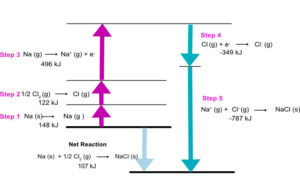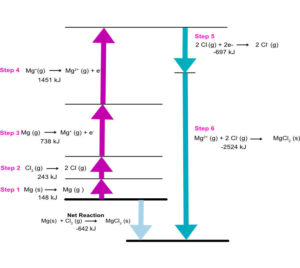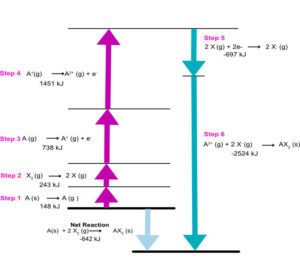Ionic compounds are salts, and we all recognize table salt which is NaCl. An ionic bond is a bond where one or more electrons is transferred from one atom to another. This creates an strong electrostatic attraction between a positively charged cation and a negatively charged anion. Sodium chloride is composed of Na ions and Cl ions. An electron is transferred from a sodium atom to a chlorine atom. The result is Na+ and Cl– ions.
The ionization energy, Ei, for Na is +496 kJ/mol and is not favorable. Recall, energy is required to remove an electron. The electron affinity, Eea for Cl is -349 kJ/mol and is favorable — energy is released. The net energy change is
The net energy change is not favorable. We must take in additional factors to determine the net energy change for the formation of NaCl. Recall, ΔE is a state function. It only depends on final and initial values and not on the path taken. Just as we did with Hess’s Law, we can use a series of steps to calculate the net energy change for the formation of an ionic compound. For NaCl we can take into consideration 5 steps. We add the 5 equations to get the net equation and add the energies for the net energy change.
Step 2. 1/2 Cl2 (g) → Cl (g) +122 kJ/0.5 mol
Step 3. Na (g) → Na+ + e– +496 kJ/mol
Step 4. Cl (g) + e– → Cl– (g) -349 kJ/mol
Step 5. Na+ (g) + Cl– (g) → NaÇl (s) -787 kJ/mol
_____________________________________________________________________
Na (s) + 1/2 Cl2 (g) → NaCl (s) ΔE = -411 kJ
The net energy is -411 kJ, and the reaction is favorable. Steps 1, 2, and 3 have positive values and steps 4 and 5 have negative values. It is Step 5 that has the most negative value — releases the most energy. Step 5 is the formation of the ionic solid from its ions. Step 1 is the sublimation of solid sodium, Step 2 is the bond dissociation energy for Cl-Cl, and step 3 is the first ionization energy for Na (g). Step 4 is the electron affinity for Cl. Step 5 gives a measure of the strength of the ionic bond between Na+ and Cl–. If it was not for the large amount of energy released in Step 5, the reaction would not take place. Notice the net reaction is for 1 mole of NaCl (s).
Below is a representation of the Born Haber Cycle. It is easy to see from the figure how the energy of each step contributes to the formation of NaCl.
Steps 1, 2, and 3 absorb energy while steps 4 and 5 release energy. It can be seen from the figure the formation of NaCl is exothermic. Note, for the bond dissociation energy, Step 2, only 0.5 moles of Cl2 is required for the reaction because there is a 1:1 ratio of sodium and chloride ions in the chemical formula for NaCl.
A Born-Haber cycle for the reaction between Mg and Cl to form MgCl2 is shown below. Note, there is a first and a second ionization energy for Mg in Steps 3 and 4. The first Ei1 is 738 kJ and Ei2 is 1451 kJ. The bond dissociation energy for Cl2 is 243 kJ. One mole of Cl2 is required because there are 2 Cl– ions for one Mg2+ ion. The step that releases the most energy is Step 6, where the ions condense to form the solid MgCl2. The net energy, ΔE, is equal to -642 kJ. The formation of an ionic compound is favorable.
In summary, to find the net energy change for the formation of an ionic compound, you will need the sublimation energy for the metal, the bond dissociation energy for the non metal, the ionization energies, the electron affinity, and the energy released when the ions condense to form the ionic solid. It is helpful to draw a Born-Haber cycle when doing these problems. The net equation is for the formation of 1 mole of ionic solid.
Worksheet: Ionic Compounds, Born-Haber Cycle, and Lattice Energy
Exercises
Exercise 1. Calculate the net energy change in kJ/mol when solid MgF2 is formed from its elements: Mg (s) + F2 (g) → MgF2 (s). Sketch a Born-Haber cycle for the process.
Exercise 2. Calculate the net energy change in kJ/mol when solid Al2O3 is formed from its elements: 2 Al (s) + 3/2 O2 (g) → Al2O3 (s).
Exercise 3. Below is a figure of a Born-Haber Cycle where A is the metal and X2 is a nonmetal. Answer the following questions.
b) What is Eea?
c) What is the net energy change for the formation of the solid?
d) What is the sublimation energy?
e) What is the energy for the formation of the solid from its ions?
Back to Periodic Trends and Ionic Compounds
Back to General Chemistry 1 Study Guides
Back to Home Page





